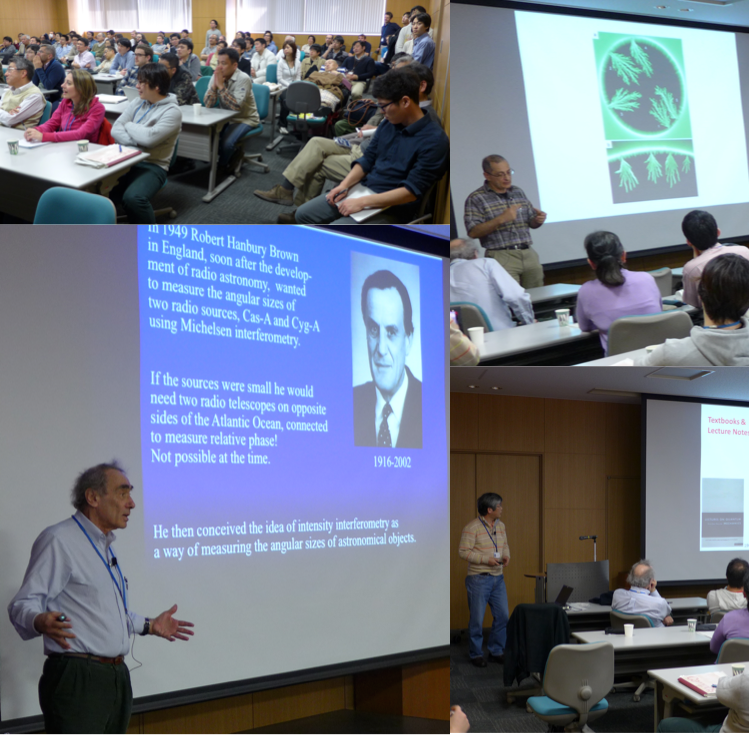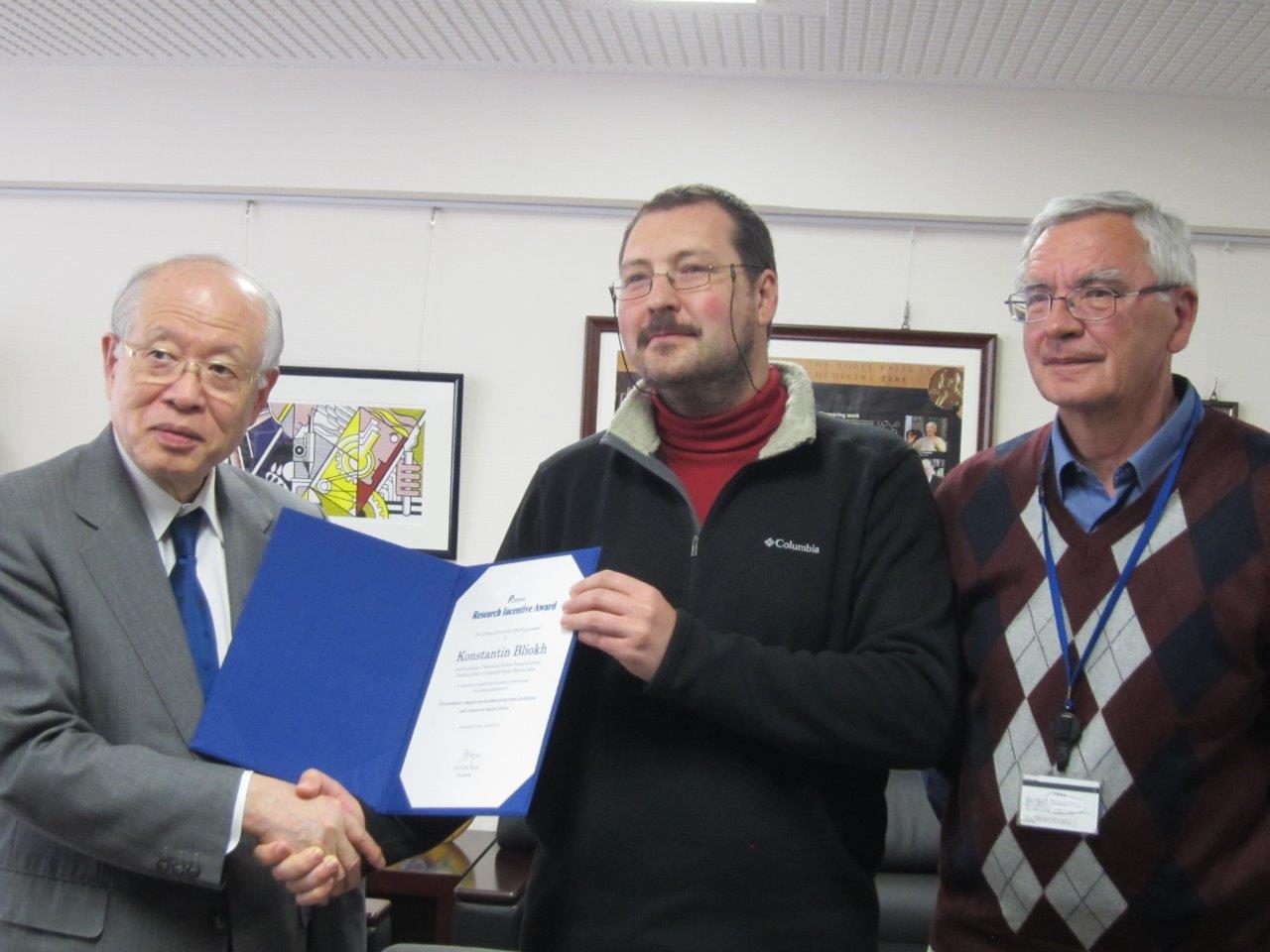|
|
|
|
Dr. Konstantin Bliokh received
RIKEN Research Incentive Award
The Researcher Incentive Award
is given to young researchers who have
contributed to furthering RIKEN's ideals
by achieving exemplary results in their research.
This year, our iTHES graduate Dr. Konstantin Bliokh
received the award for his studies on
"Extraordinary angular-momentum properties of
electron and evanescent-optical waves".
Congratulations to Kostya!
The photo was taken at the award ceremony at RIKEN
on April 7 (left: President R. Noyori,
middle: Kostya Bliokh, right: Yuri Bliokh (Kostya's father)).
|
|
|
Upcoming Events
|
|
iTHES mini workshop on
Cloaking, Photonic Lattice & Metamaterial:
Date: 13:30-, April 14, 2014
Place: RIKEN Main Research Building 4F, Seminar Room 435-437
Speakers: Tomohiro Amemiya (TiTech), Tomoki Ozawa (Univ. of Trento), Masato Taki (RIKEN), Taku Tanaka (RIKEN)
https://sites.google.com/site/ithescloaking2014/
iTHES Lecture (in Japanese)
Date: 13:30〜17:00, April 23 (Wed), 2014
Place: RIKEN Main Research Building 4F, 435-437
Speaker: Prof. Shigeru Shinomoto (Kyoto Univ.)
iTHES Seminar
Date: 13:30〜15:00, April 24 (Thu.), 2014
Place: RIKEN Main Research Building 4F, 433
Speaker: Prof. Shigeru Shinomoto (Kyoto Univ.)
Title: Reading neuronal spike trains
iTHES-IPMU-Osaka Joint Symposium,
Nov. 12 (Wed.) 2014
at Kavli IPMU, Univ. Tokyo (http://www.ipmu.jp/ )
|
|
|
Event report
 |
|
| |
An audience of over 120 people completely filled and overflowed 2F Large meeting room of RIBF building on April 8th for the occasion of iTHES colloquium by renowned Prof. Gordon Baym. Prior to Prof. Baym’s talk, Franco Nori and Tetsuo Hatsuda presented introductions. Nori’s slides included many figures and pictures explaining the background of Prof. Baym’s vast scientific works as well as historic pictures of his with other eminent scientists. Hatsuda overviewed briefly Prof. Baym’s honors, celebrated scientific papers and his widely-read textbooks.
After the introduction by Nori and Hatsuda, Prof. Baym gave a lecture on
"Hanbury Brown – Twiss (HBT) Intensity Interferometry: from stars to nuclei
to atoms and electrons". The HBT correlation is one of the remarkable
examples that the wave nature of the photon and matter-particles play
crucial and useful roles to extract the information on the phenomena
not only in astronomical scale but also in subatomic scale.
Starting from the original idea of the HBT intensity correlation to measure
the size of the distant stars, he explained how the idea was independently
discovered in elementary particle physics and was later applied to study
the size of the hot fireball in nucleus-nucleus collisions.
Also, the HBT intensity correlation experiments were conducted
using atomic and electron beams; in particular, one of the last papers
by late Dr. Akira Tonomura was on the HBT correlation in a coherent electron
beam (Phys.Rev.A 83, 063616 (2011)). At the end of his talk,
Prof. Baym discussed how to make Coulomb corrections between
charged particles for the HBT measurements in nuclear/particle physics
and in Tonomura's electron beam experiment.
Prof. Baym's slide can be seen from http://theoreticalscience.info/
|
|
|
Person of the Week
Yury Bliokh
Self-introduction
I am Yury Bliokh from the Technion – Israel Institute of Technology. I received my Ph. D. in physics from Kharkov State University in 1978 and Dr. Sci. in Ukrainian National Sci. Center – KhFTI in 1987. The first 30 years of my scientific activity were closely related to plasma electronics. This field of plasma physics studies the interaction of different kinds of plasma waves with electron beams. During 1987 – 2000, I headed a theoretical laboratory where we studied dynamical chaos in beam-plasma systems. A new mechanism of stochastization in distributed systems, which was successfully observed in experiments, has been discovered in the laboratory. Simultaneously, in collaboration with theoretical and experimental groups at the University of Maryland, I took part in the development of a new source of microwave radiation: PASOTRON. In 2000, I emigrated to Israel and started to work in Technion as a Senior Researcher. There, I provided theoretical support to experiments in plasma physics. At the same time, I have studied the propagation of waves in disordered media. Various theoretical results, obtained in collaboration with my colleagues, have been confirmed experimentally. In summary, my research interests focus on wave phenomena in any kind of media. It is especially pleasant for me that I could study these problems during my various visits to RIKEN.
|
|
|
|
|
|


